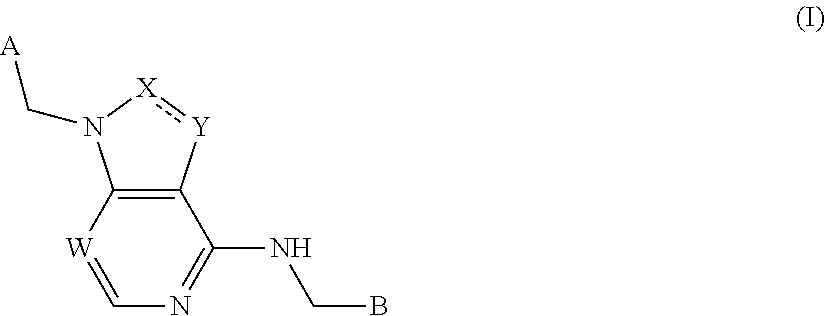Bicyclic inhibitors
a technology of bicyclic kallikrein and inhibitor, which is applied in the direction of antibacterial agents, extracellular fluid disorders, metabolic disorders, etc., can solve the problems of limited use of small molecule synthetic plasma kallikrein inhibitors, abnormal abundance of plasma kallikrein-kinin systems, and inability to meet the needs of patients,
- Summary
- Abstract
- Description
- Claims
- Application Information
AI Technical Summary
Benefits of technology
Problems solved by technology
Method used
Image
Examples
example 7
1-{4-[4-(4-Aminomethyl-benzylamino)-pyrrolo[3,2-c]pyridin-1-ylmethyl]-benzyl}-1H-pyridin-2-one
[0106]
A. 1-(4-Hydroxymethyl-benzyl)-1H-pyridin-2-one
[0107]4-(Chloromethyl)benzylalcohol (5 g, 31.93 mmol) was dissolved in acetone (150 ml), and 2-hydroxypyridine (3.6 g, 38.31 mmol) and potassium carbonate (13.2 g, 95.78 mmol) were added. The reaction mixture was stirred at 50° C. for 3 hours. The solvent was removed in vacuo and the residue taken up in chloroform (100 mL). The organic layer was washed with water (30 mL), brine (30 mL), dried (Na2SO4), filtered and evaporated. The residue was purified by flash chromatography eluting with 5% MeOH-DCM to give a white solid identified as the title compound (5.4 g, 25.09 mmol, 79% yield). [M+Na]+=237.8
B. 1-(4-Bromomethyl-benzyl)-1H-pyridin-2-one
[0108]1-(4-Hydroxymethyl-benzyl)-1H-pyridin-2-one (1 g, 4.65 mmol) was dissolved in DCM (75 ml) and phosphorous tribromide (2.5 g, 9.29 mmol) was added. The reaction was stirred at room temperature for ...
example 10
(1-Amino-isoquinolin-6-ylmethyl)-{8-[4-(4-methyl-pyrazol-1-ylmethyl)-benzyl]-7,8-dihydro-6H-pyrimido[5,4-b][1,4]oxazin-4-yl}-amine
[0119]
A. 2-((E)-2-Dimethylamino-vinyl)-terephthalonitrile ester
[0120]Methylterephthalonitrile (1.42 g, 9.99 mmol) and Bredereck's reagent (3.48 g, 19.98 mmol) were dissolved in DMF (15 mL). The reaction mixture was heated at 75° C. under nitrogen for 72 hrs after which time the solvent was removed in vacuo. Trituration with Pet Ether gave a bright yellow solid identified as 2-((E)-2-dimethylamino-vinyl)-terephthalonitrile ester (1.88 g, 0.95 mmol, 95%).
[0121]1H NMR (CD3OD) δ: 3.20 (6H, s), 5.34 (1H, d, J=13.4 Hz), 7.21 (1H, dd, J=8.0 Hz, 1.4 Hz), 7.9 (1H, d, 13.4 Hz), 7.61 (1H, d, J=8.0 Hz), 7.94 (1H, d, J=1.2 Hz)
B. 1-Amino-2-(2,4-dimethoxy-benzyl)-1,2-dihydro-isoquinoline-6-carbonitrile
[0122]2-((E)-2-Dimethylamino-vinyl)-terephthalonitrile ester (1.85 g, 9.38 mmol) was dissolved in 1,3-dimethyl-3,4,5,6-tetrahydro-2(1H)-pyrimidinone (5 mL) and 2,4-dimetho...
PUM
| Property | Measurement | Unit |
|---|---|---|
| weight | aaaaa | aaaaa |
| flow rate | aaaaa | aaaaa |
| flow rates | aaaaa | aaaaa |
Abstract
Description
Claims
Application Information
 Login to View More
Login to View More - R&D
- Intellectual Property
- Life Sciences
- Materials
- Tech Scout
- Unparalleled Data Quality
- Higher Quality Content
- 60% Fewer Hallucinations
Browse by: Latest US Patents, China's latest patents, Technical Efficacy Thesaurus, Application Domain, Technology Topic, Popular Technical Reports.
© 2025 PatSnap. All rights reserved.Legal|Privacy policy|Modern Slavery Act Transparency Statement|Sitemap|About US| Contact US: help@patsnap.com



